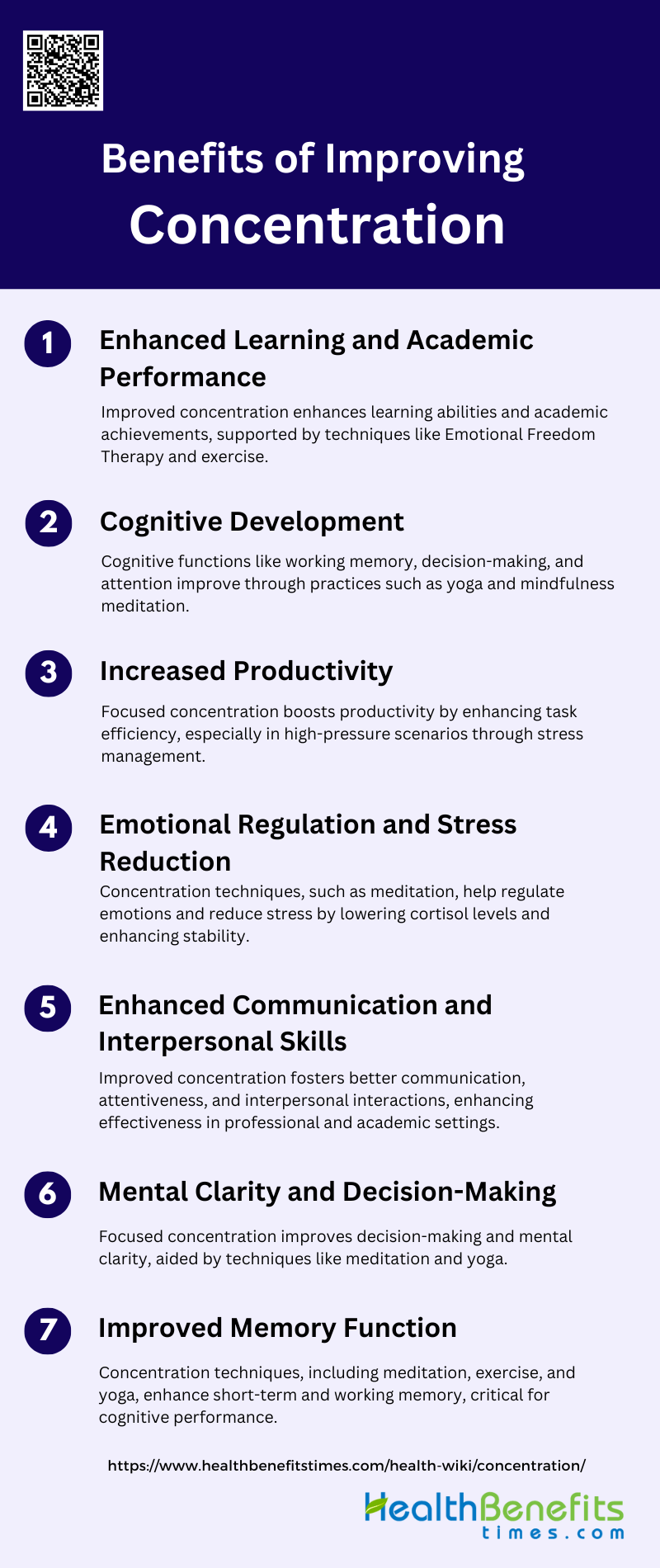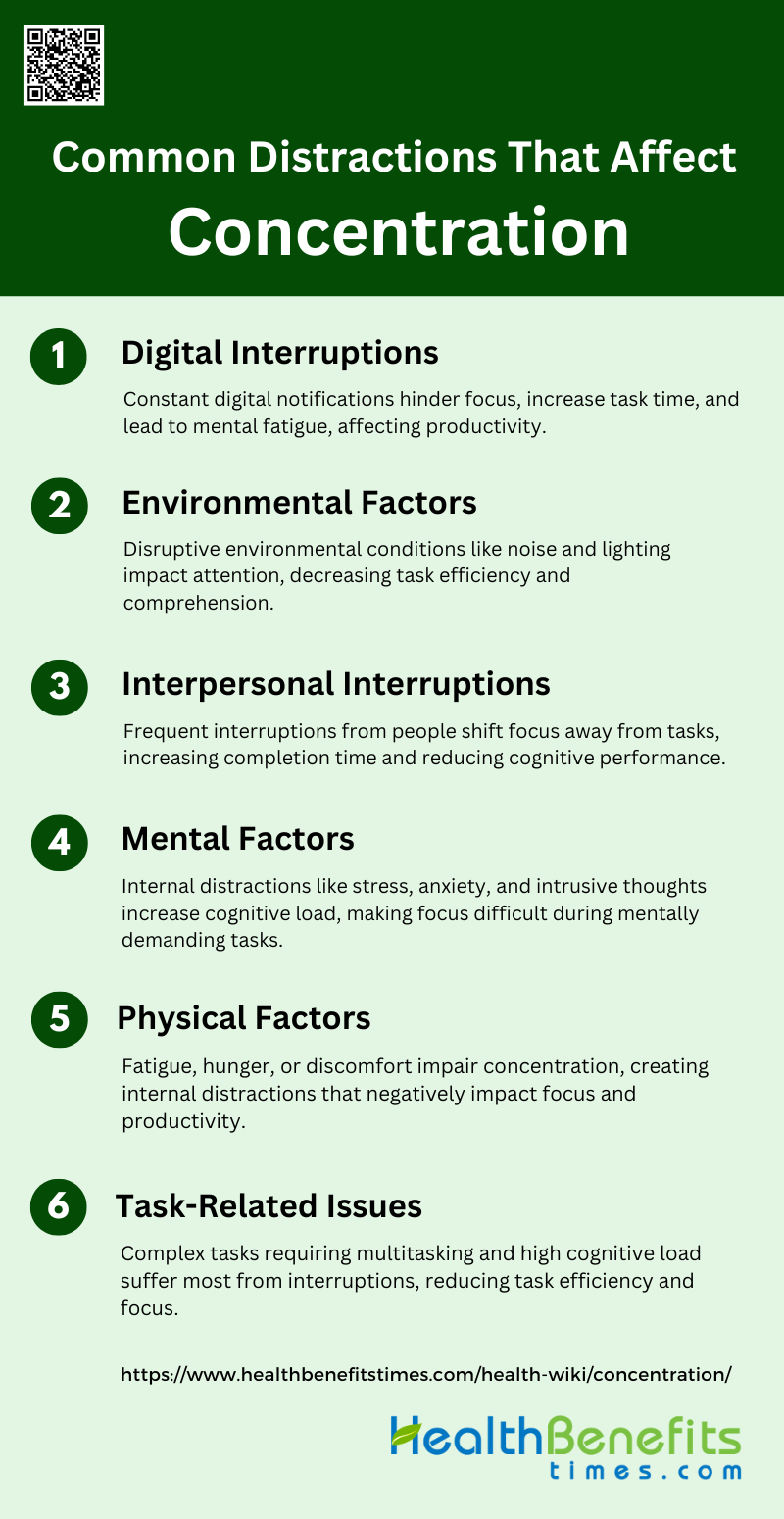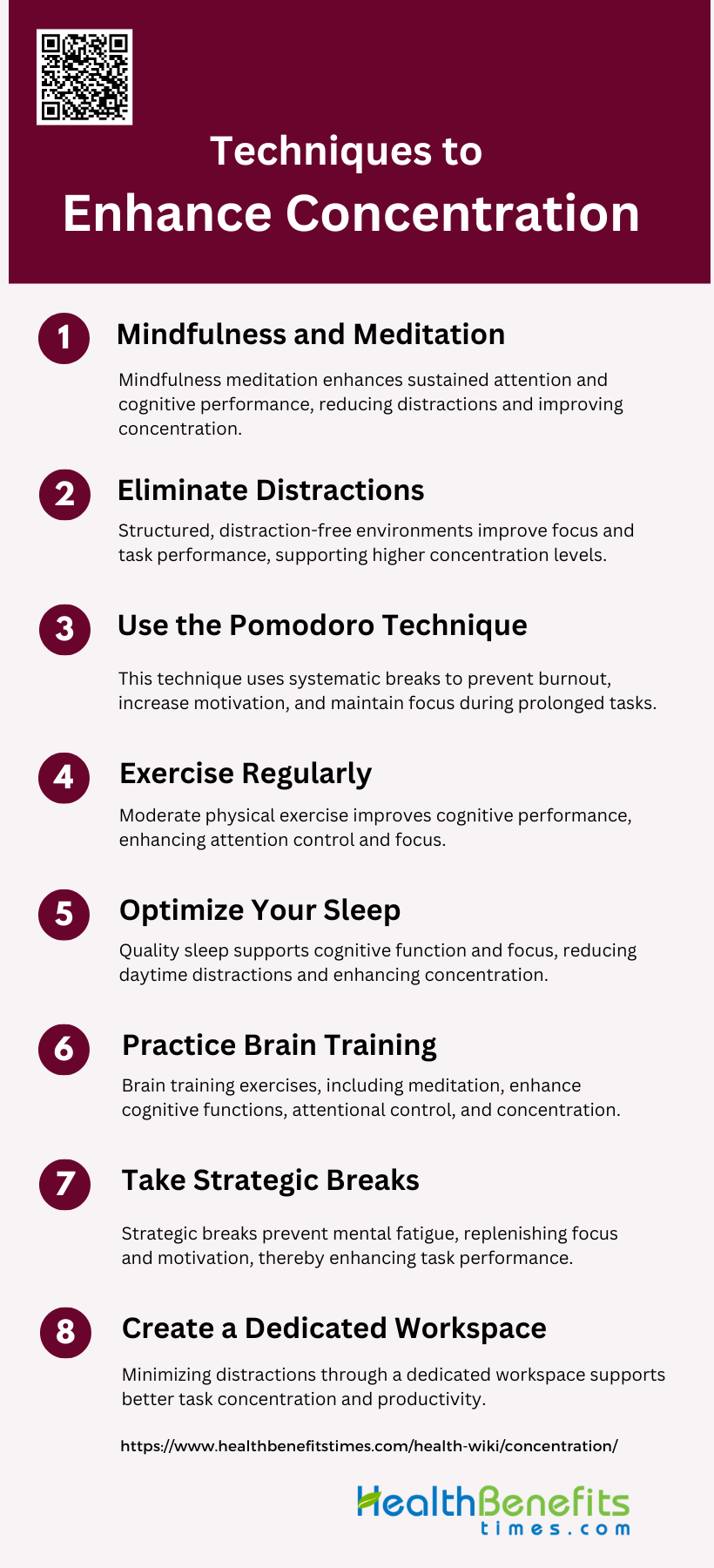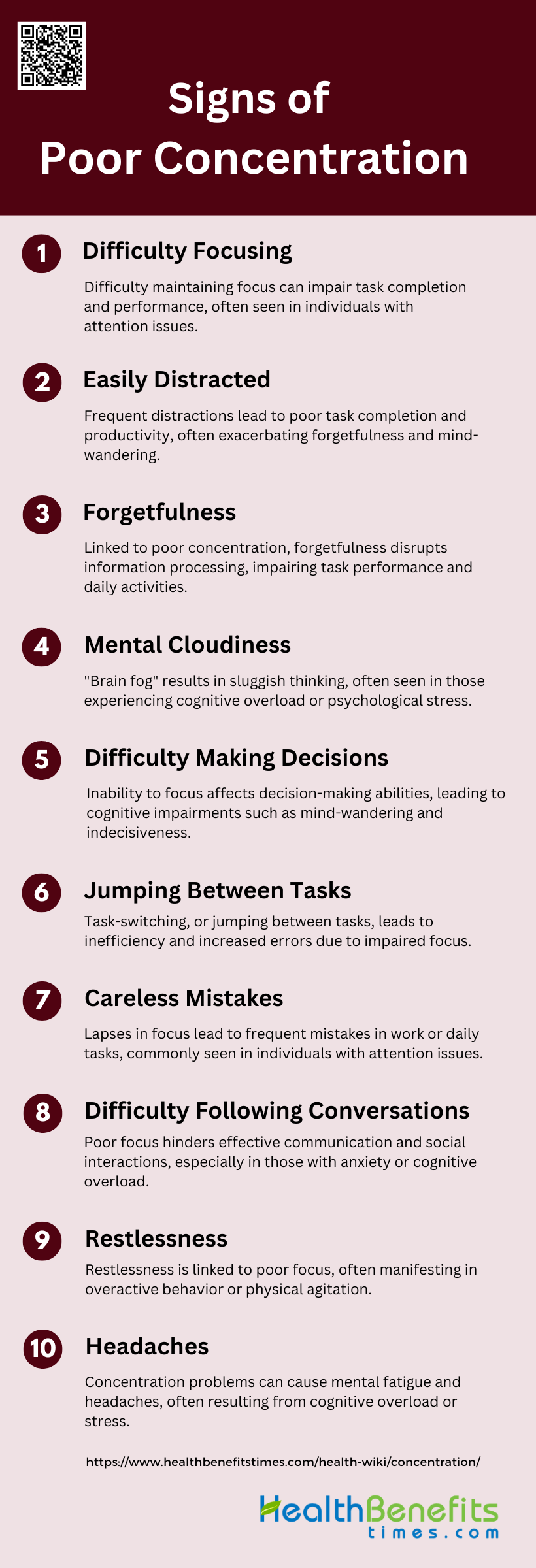Concentration refers to the amount or proportion of a substance present in a given volume or mixture. In scientific contexts, it is often expressed as a measure of the quantity of solute dissolved in a solvent, typically in units such as molarity, parts per million, or percentage by weight or volume Concentration plays a crucial role in various fields, including chemistry, biology, and environmental science, where it can significantly influence chemical reactions, biological processes, and environmental impacts. In molecular biology, for instance, the concentration of specific molecules can have a direct causal effect on cellular functions and genetic expression. Understanding and manipulating concentrations is essential in many scientific experiments, industrial processes, and medical applications, as it allows for precise control and analysis of substances and their interactions.
Types of Concentration
Concentration is the ability to focus mental effort on a specific task or thought. It can be broadly categorized into two types: voluntary and involuntary.
1. Voluntary Concentration
Voluntary concentration refers to the deliberate and conscious effort to focus attention on a specific task or stimulus. This type of concentration is often associated with activities that require sustained mental effort and cognitive control. For instance, in a study on stroke rehabilitation, voluntary exercise, such as wheel running, was found to significantly improve motor recovery and increase brain-derived neurotrophic factor (BDNF) levels in the hippocampus, indicating enhanced cognitive function and reduced stress response. Additionally, voluntary attention has been shown to enhance perceptual representation, making it more effective in tasks with high perceptual difficulty3. This suggests that voluntary concentration involves active engagement and cognitive resources to improve performance and outcomes.
2. Involuntary Concentration
Involuntary concentration, on the other hand, occurs without conscious effort and is often triggered by external stimuli. This type of concentration can be seen in reflexive responses or automatic attention shifts. For example, in stroke rehabilitation, involuntary muscle movements induced by functional electrical stimulation (FES) were used to mimic gait-like walking patterns, which also contributed to motor recovery, albeit less effectively than voluntary exercise. In the context of attention, involuntary attention affects the tendency to respond to stimuli based on their location, and its effectiveness decreases with increasing perceptual difficulty. This indicates that involuntary concentration is more reactive and less controlled, relying on automatic processes rather than deliberate cognitive effort.
How Concentration Works
The Brain’s Mechanisms behind Focusing Attention
The brain employs various mechanisms to focus attention, primarily through the alignment of neuronal oscillations to key time points of stimuli, a process known as oscillatory entrainment. This alignment allows the brain to extract pertinent information from the external world efficiently. Research has shown that lapses in attention are often characterized by high-amplitude alpha oscillations, indicating a shift from externally to internally oriented computational resources. Additionally, attention can be categorized into bottom-up and top-down processes. Bottom-up attention is driven by external stimuli that are inherently salient, while top-down attention is guided by internal factors such as prior knowledge and current goals. Both processes involve the frontoparietal network, which modulates neuronal firing rates and their variability.
Short-term vs Long-term Concentration
Concentration can be divided into short-term and long-term forms, each with distinct characteristics and neural mechanisms. Short-term concentration involves the immediate focus on a task, often requiring rapid adjustments and high levels of cognitive control. Long-term concentration, or vigilant attention, is the ability to maintain focus over extended periods, which is crucial for tasks that are repetitive and cognitively simple. This type of attention is supported by a network of right-lateralized brain regions, including the prefrontal cortex, anterior insula, and parietal areas. Additionally, the visual-attention system exhibits both short-term and long-term plasticity, with habituation to repeated stimuli reducing distraction over time. This habituation can be surprisingly resistant to spontaneous recovery, indicating enduring changes in attentional mechanisms.
Factors That Affect Concentration
Concentration is influenced by a variety of internal and external factors. Internally, factors such as prior knowledge, willful plans, and current goals play a significant role in guiding attention. These top-down processes are mediated by the frontoparietal network, which modulates neuronal activity based on internal states. Externally, salient stimuli in the environment can capture attention through bottom-up processes, which are also mediated by the frontoparietal network but are driven by the inherent properties of the stimuli. Additionally, the focus of attention, whether internal or external, can modulate neural activity in specific brain regions. For instance, an external focus of attention enhances motor performance and alters intracortical inhibition within the primary motor cortex. Furthermore, attention can modulate responses in the lateral geniculate nucleus, enhancing neural responses to attended stimuli and attenuating responses to ignored stimuli.
Benefits of Improving Concentration
Improving concentration offers numerous advantages that can positively impact various aspects of life. From academic achievements to personal well-being, enhanced focus can lead to significant improvements. Below are some key benefits of improving concentration:
1. Enhanced Learning and Academic Performance
Improving concentration has a direct impact on learning and academic performance. Studies have shown that techniques such as Emotional Freedom Techniques (EFT) therapy can significantly enhance students’ learning concentration, leading to better academic outcomes. Additionally, exercise has been found to improve cognitive functions, including memory and attention, which are crucial for academic success. Progressive muscle relaxation (PMR) training has also been shown to reduce stress and anxiety, thereby freeing up working memory and improving academic performance among health science students. These findings suggest that interventions aimed at improving concentration can lead to significant improvements in academic performance.
2. Cognitive Development
Concentration plays a vital role in cognitive development, particularly in enhancing executive functions such as working memory, attention, and decision-making. Yoga and meditation practices have been shown to improve these cognitive functions by reducing stress and promoting mental clarity. For instance, a study on the effects of yoga on medical students found significant improvements in attention, concentration, and memory after 12 weeks of practice. Similarly, mindfulness-based mental training has been shown to enhance working memory, which is a critical component of cognitive development. These practices help in developing a more focused and efficient cognitive system.
3. Increased Productivity
Improving concentration can lead to increased productivity by enabling individuals to focus better on tasks and complete them more efficiently. Acute stress has been found to improve concentration performance, which can be beneficial in high-pressure situations. Additionally, daily meditation practices have been shown to enhance attention and working memory, leading to better task performance and increased productivity. By reducing distractions and improving focus, individuals can achieve more in less time, thereby boosting their overall productivity.
4. Emotional Regulation and Stress Reduction
Concentration improvement techniques such as meditation and yoga are effective in emotional regulation and stress reduction. These practices help in balancing the body’s stress response systems, leading to lower cortisol levels and reduced anxiety. For example, brief daily meditation has been shown to decrease negative mood states and enhance emotional regulation, making individuals better equipped to handle stress. By improving concentration, these techniques also help in maintaining emotional stability, which is crucial for overall well-being.
5. Enhanced Communication and Interpersonal Skills
Improved concentration can enhance communication and interpersonal skills by enabling individuals to be more present and attentive during interactions. Techniques like meditation and yoga promote mental clarity and emotional regulation, which are essential for effective communication. By reducing stress and improving focus, individuals can better understand and respond to others, leading to more meaningful and productive interactions. This can be particularly beneficial in professional and academic settings where effective communication is key to success.
6. Mental Clarity and Decision-Making
Improving concentration leads to better mental clarity and decision-making abilities. Practices such as yoga and meditation have been shown to enhance executive functions, including decision-making and problem-solving skills. For instance, a study on the effects of yoga on older adults found that regular practice led to improved working memory and cognitive performance, which are essential for making informed decisions. By reducing mental clutter and enhancing focus, individuals can make more rational and effective decisions.
7. Improved Memory Function
Concentration improvement techniques have a significant impact on memory function. Exercise, meditation, and yoga have all been shown to enhance various aspects of memory, including short-term and working memory. For example, a study on the effects of combining meditation techniques found improved short-term memory and cognitive function in college students. Similarly, yoga practice has been shown to significantly improve memory function in medical students. These findings highlight the importance of concentration in maintaining and enhancing memory capabilities.
Common Distractions That Affect Concentration
Distractions can significantly hinder our ability to focus and complete tasks efficiently. Understanding the common sources of distractions can help in developing strategies to minimize their impact. Below are some of the most prevalent distractions that affect concentration:
1. Digital Interruptions
Digital interruptions, such as notifications from emails, instant messages, and app alerts, significantly impact concentration and task performance. These interruptions can lead to increased task completion time and decreased performance, as shown by neuroimaging studies that recorded brain activity during such interruptions. The constant influx of digital notifications creates a state of technostress, particularly affecting older adults who may have a higher mental workload and stress levels due to age-related differences in cognitive processing. Moreover, the need to frequently switch attention between tasks can disrupt the flow of work, leading to reduced efficiency and increased cognitive load.
2. Environmental Factors
Environmental factors, such as noise, lighting, and workspace layout, play a crucial role in affecting concentration. External interruptions from the physical environment, like sudden noises or changes in lighting, can disrupt attention and contribute to feelings of boredom or frustration, especially during tasks that require sustained attention. Studies have shown that such environmental distractions can lead to decreased reading efficiency and comprehension, as participants often need to re-read sections to regain focus. The complexity of the task and the nature of the interruption also influence how significantly these environmental factors impact performance.
3. Interpersonal Interruptions
Interpersonal interruptions, such as colleagues stopping by for a chat or phone calls, can significantly disrupt concentration and task performance. These interruptions require the individual to shift their focus from the task at hand to the interaction, which can lead to increased task completion time and decreased performance. The impact of these interruptions can be more pronounced in tasks that require high levels of working memory and cognitive processing, as the need to reorient attention back to the task can be challenging. Additionally, the frequency and timing of these interruptions can exacerbate their negative effects on productivity and mental workload.
4. Mental Factors
Mental factors, including stress, anxiety, and internal thoughts, can significantly affect concentration. Internal interruptions, such as non-task-related thoughts or concerns, can lead to decreased task performance and increased feelings of boredom and dissatisfaction. These mental distractions can be particularly detrimental during tasks that require sustained attention and working memory, as they can lead to increased cognitive load and reduced efficiency. The ability to manage and regulate these internal distractions is crucial for maintaining focus and achieving optimal task performance.
5. Physical Factors
Physical factors, such as fatigue, hunger, and discomfort, can also impact concentration and task performance. Physical discomfort or fatigue can lead to decreased attention and increased errors, as the individual may struggle to maintain focus on the task at hand. Additionally, physical needs, such as hunger or the need for a break, can create internal distractions that further disrupt concentration. Addressing these physical factors through proper ergonomics, regular breaks, and maintaining a healthy lifestyle can help mitigate their impact on concentration and productivity.
6. Task-Related Issues
Task-related issues, such as task complexity and the need for multitasking, can significantly affect concentration. Complex tasks that require high levels of cognitive processing and working memory are more susceptible to the negative effects of interruptions and distractions. The need to frequently switch between tasks can lead to increased cognitive load and reduced efficiency, as the individual may struggle to reorient their attention and maintain focus. Understanding the nature of the task and implementing strategies to minimize interruptions can help improve concentration and task performance.
Techniques to Enhance Concentration
Enhancing concentration is essential for improving productivity and achieving goals. Various techniques can help sharpen focus and maintain attention on tasks. Below are some effective methods to enhance concentration:
1. Mindfulness and Meditation
Mindfulness and meditation have been shown to significantly enhance attention and concentration. Studies indicate that mindfulness training can improve sustained attention, reduce mind wandering, and enhance cognitive performance. For instance, a randomized controlled trial demonstrated that mindfulness meditation led to significant improvements in sustained attention and signal detection tasks, suggesting enhanced concentration abilities. Another study found that short-term meditation training improved attention and self-regulation, highlighting its potential for enhancing focus. Additionally, mindfulness practices supported by brain-sensing devices have been shown to optimize cognitive performance and neural efficiency, further supporting their role in enhancing concentration.
2. Eliminate Distractions
Eliminating distractions is crucial for maintaining concentration. Research suggests that structured environments with minimal distractions can significantly improve focus and task performance. For example, a study comparing systematic breaks (such as the Pomodoro Technique) with self-regulated breaks found that systematic breaks led to higher levels of concentration and motivation, as well as lower levels of fatigue and distractedness. This indicates that creating a distraction-free environment and using structured breaks can help maintain high levels of concentration during tasks.
3. Use the Pomodoro Technique
The Pomodoro Technique, which involves taking systematic breaks, has been shown to enhance concentration and task efficiency. A study comparing systematic breaks with self-regulated breaks found that students who used the Pomodoro Technique had longer study sessions with higher levels of concentration and motivation, and lower levels of fatigue and distractedness. This technique helps in managing mental effort and maintaining focus by providing regular intervals of rest, which can prevent burnout and improve overall productivity.
4. Exercise Regularly
Regular physical exercise has been linked to improved cognitive function and concentration. A randomized controlled trial found that moderate-intensity exercise significantly improved sleep quality, which is closely related to cognitive performance and concentration. Another study comparing mindfulness meditation, biofeedback exercises, and physical exercise found that all three interventions, including physical exercise, were effective in improving attention control and executive functioning. These findings suggest that incorporating regular exercise into one’s routine can enhance concentration and cognitive abilities.
5. Optimize Your Sleep
Optimizing sleep is essential for maintaining high levels of concentration. Research has shown that both mindfulness-based stress reduction (MBSR) and moderate-intensity exercise can improve sleep quality, which in turn enhances cognitive performance and concentration. Improved sleep quality leads to better attention regulation and reduced daytime disturbances, making it easier to maintain focus during tasks. Ensuring adequate and quality sleep is therefore a critical factor in enhancing concentration.
6. Practice Brain Training
Brain training exercises can improve cognitive functions related to concentration. A study on older adults found that engaging in brain training exercises led to significant improvements in attentional control and emotion regulation processes. Another study on nursing students demonstrated that meditation, a form of brain training, enhanced attentional efficiency and reduced stress. These findings suggest that regular practice of brain training exercises can enhance cognitive abilities and concentration.
7. Take Strategic Breaks
Taking strategic breaks is important for maintaining concentration and preventing cognitive fatigue. Research comparing systematic breaks with self-regulated breaks found that systematic breaks, such as those used in the Pomodoro Technique, led to higher levels of concentration and motivation, and lower levels of fatigue and distractedness. Strategic breaks help in replenishing mental resources and maintaining high levels of focus during tasks, making them an effective strategy for enhancing concentration.
8. Create a Dedicated Workspace
Creating a dedicated workspace can significantly improve concentration by minimizing distractions and providing a structured environment for focused work. Studies have shown that environments with minimal distractions and structured breaks lead to better task performance and higher levels of concentration. A dedicated workspace helps in establishing a routine and reducing cognitive load, allowing for sustained focus and improved productivity.
Signs of Poor Concentration
Poor concentration can significantly impact daily activities and overall productivity. Recognizing the signs of poor concentration is the first step towards addressing and improving it. Below are some common indicators of poor concentration:
1. Difficulty Focusing
Difficulty focusing is a common symptom of poor concentration, often observed in various conditions such as depression and post-infection states. For instance, individuals recovering from glandular fever frequently report challenges in maintaining focus, which can be exacerbated by psychiatric morbidity and fatigue. In educational settings, children with attention problems often struggle to complete tasks consistently and may find their vision drifting towards non-instructional activities, such as staring out the window. This inability to focus can significantly impair academic and social functioning, highlighting the need for targeted interventions to improve attentional control.
2. Easily Distracted
Being easily distracted is another hallmark of poor concentration. This symptom is particularly evident in children and adolescents, who may exhibit behaviors such as inconsistent completion of schoolwork and a tendency to focus on non-instructional activities. In depressed patients, distraction can manifest as mind-wandering, where the mind shifts away from the task at hand to unrelated thoughts, leading to poor memory retention and longer planning times for tasks. These distractions can severely impact daily functioning and productivity, necessitating strategies to minimize environmental distractions and improve focus.
3. Forgetfulness
Forgetfulness is often linked to poor concentration and can be a significant barrier to effective information processing. In the context of post-infection recovery, individuals may experience heightened forgetfulness, particularly when psychiatric disorders and fatigue states are present. This symptom is also prevalent in children with inattentive behavior, who may struggle with recalling instructions and completing tasks. Forgetfulness can hinder academic performance and daily activities, making it crucial to address underlying concentration issues to improve memory retention and cognitive function.
4. Mental Cloudiness
Mental cloudiness, or “brain fog,” is characterized by a sense of confusion and sluggish cognitive processing. This symptom is commonly reported by individuals with sluggish cognitive tempo (SCT), which includes excessive daydreaming and low motivation. In cancer patients, mental cloudiness can result from the disease itself, its treatment, and the psychological stress of a life-threatening illness. Addressing mental cloudiness involves managing underlying health conditions and employing cognitive strategies to enhance mental clarity and attentional capacity.
5. Difficulty Making Decisions
Difficulty making decisions is a frequent complaint among individuals with poor concentration. Depressed patients, for example, often report an inability to concentrate, which can extend to challenges in decision-making. This difficulty is linked to cognitive impairments such as mind-wandering and blanking, which disrupt the decision-making process. Effective decision-making requires focused attention and cognitive clarity, both of which are compromised in individuals with concentration problems. Interventions aimed at improving cognitive function and reducing psychiatric symptoms can help alleviate decision-making difficulties.
6. Jumping Between Tasks
Jumping between tasks, or task-switching, is a common behavior in individuals with poor concentration. This symptom is particularly evident in children with attention problems, who may struggle with organization and consistency in their work. In depressed patients, task-switching can result from mind-wandering, where the individual’s attention shifts from one task to another without completing the initial task. This behavior can lead to inefficiency and increased errors, underscoring the need for strategies to enhance task focus and completion.
7. Careless Mistakes
Careless mistakes are often a direct consequence of poor concentration. In educational settings, children with attention problems may make frequent errors in their schoolwork due to lapses in focus and organization. Depressed individuals also report making mistakes in daily activities, which can be attributed to cognitive impairments such as mind-wandering and blanking. Addressing the root causes of poor concentration, such as psychiatric conditions and cognitive dysfunction, is essential to reduce the occurrence of careless mistakes.
8. Difficulty Following Conversations
Difficulty following conversations is a symptom of poor concentration that can significantly impact social interactions. This issue is prevalent in individuals with social anxiety, who may find it challenging to concentrate in social settings, leading to impaired communication and understanding. Depressed patients also report difficulties in following conversations, often due to mind-wandering and cognitive overload. Improving concentration through therapeutic interventions can enhance social functioning and communication skills.
9. Restlessness
Restlessness is a common symptom associated with poor concentration, particularly in children with attention problems. These children may exhibit overactive and impulsive behaviors, making it difficult for them to stay still and focus on tasks. In adults, restlessness can be a manifestation of psychiatric conditions such as anxiety and depression, where the inability to concentrate leads to physical and mental agitation. Managing restlessness involves addressing the underlying psychological and cognitive issues to promote calmness and focus.
10. Headaches
Headaches are a physical symptom that can accompany poor concentration. In individuals with cancer, the stress and cognitive demands of the illness can lead to attentional fatigue and headaches. Depressed patients may also experience headaches as a result of cognitive strain and the mental effort required to maintain focus. Addressing headaches involves managing both the physical and psychological factors contributing to poor concentration, such as stress, fatigue, and cognitive overload.
When to Seek Help for Concentration Issues
Understanding ADHD and Other Attention-Related Disorders
Attention Deficit Hyperactivity Disorder (ADHD) is a prevalent neurodevelopmental disorder that manifests in childhood and often persists into adulthood. It is characterized by symptoms of inattention, hyperactivity, and impulsivity, which can significantly impair academic performance, vocational success, and social-emotional development. ADHD is associated with deficits in executive function, emotional regulation, and motivation, making it a serious clinical problem that affects social interactions and employment performance. Non-pharmacological interventions, such as cognitive-behavioral therapy (CBT), neurofeedback, and physical exercises, have shown positive effects on cognitive difficulties associated with ADHD, highlighting the importance of comprehensive treatment approaches.
Professional Help and Cognitive Therapy
Seeking professional help for concentration issues, particularly for ADHD, often involves a combination of pharmacological and non-pharmacological treatments. Cognitive-behavioral therapy (CBT) has been identified as an effective intervention for adults with ADHD, helping to manage core symptoms and improve emotional regulation and self-esteem. CBT aims to change the thoughts and behaviors that reinforce the harmful effects of ADHD by teaching techniques to control symptoms and cope with associated emotions like anxiety and depression. Additionally, meditation therapies and other psychological treatments, such as mindfulness and dialectical behavior therapy, have shown potential benefits, although more research is needed to establish their efficacy.
Available Tools and Apps to Improve Concentration
Digital health interventions, including mobile apps, are emerging as promising tools for managing ADHD and improving concentration. These apps offer accessible and scalable solutions for both assessment and treatment of ADHD symptoms. For instance, the AKL-T01 digital therapeutic, delivered through a video game-like interface, has shown potential in improving attentional performance in pediatric patients with ADHD. Similarly, the Inflow app, based on cognitive-behavioral therapy, has demonstrated usability and feasibility in reducing ADHD symptoms and impairment in adults. Despite the proliferation of ADHD apps, there is a need for more research to establish their safety and efficacy.
FAQs
1. How is concentration measured in scientific studies?
Concentration can be measured using various methods depending on the field of study. In chemistry, for instance, concentration is often measured in molarity (moles of solute per liter of solution). In psychology or neuroscience, attention and concentration are measured through behavioral tests, brain imaging, or tracking task performance over time.
2. How does concentration affect decision-making?
Improved concentration enhances the ability to analyze information and make informed decisions. When concentration is low, decision-making may be slower or more prone to errors due to distractions or incomplete cognitive processing.
3. Can certain foods or supplements improve concentration?
Yes, certain foods and supplements are known to boost concentration. Omega-3 fatty acids, found in fish oil, have been linked to better cognitive function. Additionally, caffeine, green tea, and supplements like Ginkgo biloba or Bacopa monnieri may help enhance focus.
4. What role does hydration play in concentration?
Staying hydrated is crucial for maintaining concentration. Even mild dehydration can lead to reduced cognitive performance, including slower reaction times and decreased ability to focus on tasks.
5. How can mindfulness meditation improve concentration?
Mindfulness meditation trains the brain to focus on the present moment, reducing mind-wandering and distractions. Regular practice can enhance sustained attention and improve the brain’s ability to concentrate on tasks.
6. How does multitasking affect concentration?
Multitasking often reduces concentration because the brain switches between tasks rather than focusing on one. This can lead to cognitive overload, lower efficiency, and increased errors.
7. Can concentration be improved with brain games or apps?
Yes, various brain games and apps are designed to improve concentration by engaging users in activities that challenge cognitive abilities, such as memory, attention, and problem-solving tasks.
8. How does physical activity impact concentration?
Regular physical activity increases blood flow to the brain, improving overall cognitive function, including concentration. Studies show that aerobic exercises, like running or swimming, can boost attention and focus.
9. What is the difference between concentration and attention?
Concentration refers to sustained focus on a particular task or thought, while attention involves the ability to notice or process information. Attention can be broad, but concentration is a more intense, focused form of attention on a specific subject.
10. Can poor concentration be a sign of an underlying health issue?
Yes, chronic poor concentration may be a symptom of underlying health issues such as ADHD, depression, anxiety, or even neurological conditions like dementia. If concentration problems persist, it may be necessary to seek professional help.






